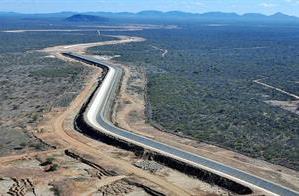Publicado em 13 de janeiro de 2014
Survey indicates investments of R$ 1.19 trillion in works until 2018
There are 8300 works being carried out, being designed or in intention, spread through eight areas of economy

The survey shows 8300 works that are being carried out, being designed or in intention, in eight areas of economy—oil and gas, transport, power, sanitation, industry, habitation infrastructure, sports infrastructure and others—divided by region and state. It also presents an overview and details information about the 30 main works of each area.
The area of economy that corresponds to the largest part of theses investments is transportation. A total of R$ 369.6 billion—that represents 30.94 percent of the scheduled total—is estimated to be invested between 2013 and 2018. The high-speed train (TAV) is still the work with the highest visibility and value, about R$ 34.6 billion. The other modes of transportation that concentrate the highest investments are railways (25.3 percent) and roads (14.3 percent). The amount to be allocated to these three modes of transportation is strategic to reduce the existing bottlenecks of logistics that result in additional costs to the whole production chain of several industries, specially the agribusiness. In 2012, the investment in transport represented only 0.92 percent of Brazilian GDP.
With values next to those of transportation—R$ 346.6 billion (29.02 percent of the total investment)—the area of oil and gas comes in the second place. The new Business Plan of Petrobras (PNG 2013-2017) defined 947 projects with investments of US$ 236.7 billion. In Exploration and Production (E&P), that represents 62.3 percent of the total, the most expressive figures are in production development, mainly of the reserves discovered in pre-salt areas.
According to the survey Main Infrastructure Investments in Brazil until 2018, power industry has foreseen investments of R$ 196.1 billion, mainly for power generation works, that represent 87.6 percent of the total. The evolution of the relationship between renewable (46 percent) and non-renewable (54 percent) sources remains stable, highlighting the continuous growth of alternative renewable sources that represented 3.1 percent in 2003 and 4.6 percent in 2012. The offer of power grew only 0.3 percent, once again below the GDP and the population growth. The consumption increased 3.8 percent in 2012.
One of the main challenges in the area of infrastructure occurs in basic sanitation, where the availability of sewage collection and treatment for the whole population is a very distant goal to be achieved. According to data about sanitation that came from the SNIS—Sistema Nacional de Informações—only 48 percent of the population has its sewage collected and only 37.5 percent has its sewage treated. In Sobratema’s survey, this area will receive investments of R$ 55.6 billion until 2018. Nevertheless, the Plano Nacional de Saneamento Básico (Plansab) schedules about R$ 508.5 billion in water supply, sewage collection and treatment and draining works between 2014 and 2030. From the total investment scheduled, R$ 298 billion will come from the federal government and R$ 210 billion will come from other agents.
In the habitation industry, the program Minha Casa Minha Vida (My House my Life) is showing the highest conclusion rate of the PAC2 – Programa de Aceleração da Economia. Until August, 2013, a total of 1.32 million of habitations—corresponding to an investment of R$ 278 billion—was concluded and delivered to a population of more than 4.6 million inhabitants. Investments foreseen only for habitation infrastructure until 2018 are of about R$ 10.5 billion.
Sports infrastructure is also considered in the survey Main Infrastructure Investments in Brazil until 2018. A total of R$ 5.4 billion will be invested between 2013 and 2018 in arenas, stadiums and facilities for 2014 World Cup and 2016 Olympic Games. Hotels and resorts, malls, hospitals, universities, theaters and public buildings will receive R$ 65.4 billion and the industrial area will receive R$ 145.3 billion of investments in the same period.

Av. Francisco Matarazzo, 404 Cj. 701/703 Água Branca - CEP 05001-000 São Paulo/SP
Telefone (11) 3662-4159
© Sobratema. A reprodução do conteúdo total ou parcial é autorizada, desde que citada a fonte. Política de privacidade


